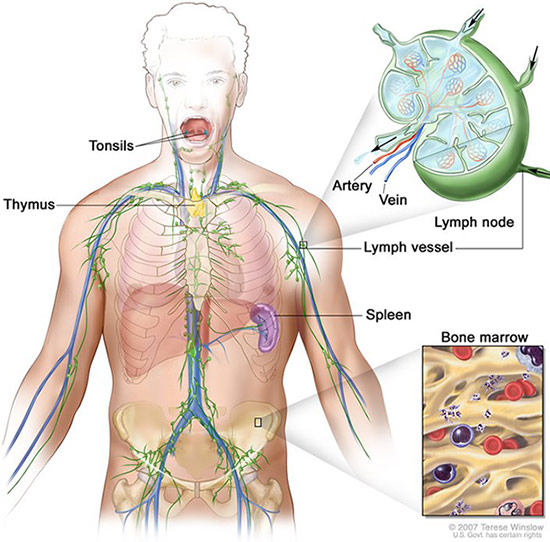Statistics at a Glance
At a Glance
Estimated New Cases in 2024 8,570
% of All New Cancer Cases 0.4%
Estimated Deaths in 2024 910
% of All Cancer Deaths 0.1%
5-Year
Relative Survival
| Year | Rate of New Cases — SEER 8 | Rate of New Cases — SEER 12 | Death Rate — U.S. | 5-Year Relative Survival — SEER 8 | ||||
|---|---|---|---|---|---|---|---|---|
| Observed | Modeled Trend | Observed | Modeled Trend | Observed | Modeled Trend | Observed | Modeled Trend | |
| 1975 | 3.09 | 2.84 | - | - | 1.31 | 1.29 | 70.40% | 71.52% |
| 1976 | 2.75 | 2.85 | - | - | 1.17 | 1.21 | 75.12% | 72.26% |
| 1977 | 2.93 | 2.86 | - | - | 1.14 | 1.13 | 73.00% | 72.99% |
| 1978 | 2.75 | 2.87 | - | - | 1.06 | 1.06 | 71.28% | 73.70% |
| 1979 | 2.81 | 2.89 | - | - | 0.97 | 0.99 | 69.05% | 74.40% |
| 1980 | 2.85 | 2.90 | - | - | 0.98 | 0.95 | 75.22% | 75.08% |
| 1981 | 2.86 | 2.91 | - | - | 0.93 | 0.92 | 75.83% | 75.75% |
| 1982 | 2.82 | 2.92 | - | - | 0.88 | 0.89 | 72.92% | 76.40% |
| 1983 | 3.04 | 2.93 | - | - | 0.85 | 0.86 | 76.68% | 77.04% |
| 1984 | 3.00 | 2.94 | - | - | 0.86 | 0.83 | 78.99% | 77.66% |
| 1985 | 3.03 | 2.95 | - | - | 0.77 | 0.80 | 80.59% | 78.27% |
| 1986 | 2.70 | 2.97 | - | - | 0.78 | 0.77 | 79.05% | 78.86% |
| 1987 | 3.02 | 2.98 | - | - | 0.74 | 0.74 | 77.89% | 79.44% |
| 1988 | 3.09 | 2.99 | - | - | 0.67 | 0.72 | 80.94% | 80.01% |
| 1989 | 3.05 | 2.96 | - | - | 0.71 | 0.69 | 80.38% | 80.56% |
| 1990 | 2.98 | 2.93 | - | - | 0.66 | 0.67 | 81.03% | 81.10% |
| 1991 | 2.94 | 2.90 | - | - | 0.65 | 0.64 | 81.01% | 81.63% |
| 1992 | 2.81 | 2.87 | 2.68 | 2.58 | 0.65 | 0.62 | 84.49% | 82.14% |
| 1993 | 2.78 | 2.84 | 2.69 | 2.59 | 0.61 | 0.60 | 79.76% | 82.64% |
| 1994 | 2.79 | 2.81 | 2.59 | 2.61 | 0.56 | 0.58 | 84.74% | 83.13% |
| 1995 | 2.62 | 2.79 | 2.50 | 2.62 | 0.55 | 0.56 | 82.47% | 83.60% |
| 1996 | 2.82 | 2.76 | 2.65 | 2.63 | 0.53 | 0.54 | 83.99% | 84.07% |
| 1997 | 2.75 | 2.73 | 2.62 | 2.64 | 0.53 | 0.52 | 88.34% | 84.52% |
| 1998 | 2.72 | 2.70 | 2.65 | 2.65 | 0.48 | 0.50 | 86.81% | 84.96% |
| 1999 | 2.72 | 2.68 | 2.70 | 2.66 | 0.51 | 0.49 | 84.29% | 85.39% |
| 2000 | 2.78 | 2.65 | 2.60 | 2.67 | 0.46 | 0.48 | 85.82% | 85.80% |
| 2001 | 2.50 | 2.62 | 2.57 | 2.68 | 0.47 | 0.47 | 86.65% | 86.21% |
| 2002 | 2.83 | 2.72 | 2.63 | 2.69 | 0.47 | 0.46 | 85.61% | 86.61% |
| 2003 | 2.68 | 2.81 | 2.64 | 2.71 | 0.46 | 0.45 | 89.65% | 86.99% |
| 2004 | 2.89 | 2.91 | 2.74 | 2.72 | 0.43 | 0.44 | 85.63% | 87.37% |
| 2005 | 3.01 | 3.01 | 2.81 | 2.73 | 0.42 | 0.43 | 88.99% | 87.73% |
| 2006 | 2.93 | 2.96 | 2.78 | 2.74 | 0.44 | 0.42 | 89.38% | 88.09% |
| 2007 | 3.05 | 2.92 | 2.89 | 2.75 | 0.41 | 0.41 | 89.01% | 88.43% |
| 2008 | 2.86 | 2.87 | 2.69 | 2.71 | 0.37 | 0.40 | 90.92% | 88.77% |
| 2009 | 2.86 | 2.83 | 2.69 | 2.67 | 0.40 | 0.39 | 85.84% | 89.09% |
| 2010 | 2.85 | 2.78 | 2.74 | 2.63 | 0.38 | 0.37 | 87.98% | 89.41% |
| 2011 | 2.67 | 2.74 | 2.55 | 2.60 | 0.36 | 0.36 | 90.20% | 89.72% |
| 2012 | 2.64 | 2.70 | 2.50 | 2.56 | 0.34 | 0.34 | 91.61% | 90.02% |
| 2013 | 2.60 | 2.66 | 2.45 | 2.52 | 0.32 | 0.33 | 90.25% | 90.31% |
| 2014 | 2.68 | 2.61 | 2.51 | 2.48 | 0.31 | 0.31 | 91.96% | 90.60% |
| 2015 | 2.61 | 2.57 | 2.38 | 2.45 | 0.32 | 0.30 | 89.71% | 90.88% |
| 2016 | 2.58 | 2.53 | 2.46 | 2.41 | 0.28 | 0.29 | 90.96% | 91.14% |
| 2017 | 2.28 | 2.49 | 2.20 | 2.38 | 0.27 | 0.27 | - | 91.41% |
| 2018 | 2.44 | 2.46 | 2.27 | 2.34 | 0.27 | 0.26 | - | 91.66% |
| 2019 | 2.48 | 2.42 | 2.43 | 2.31 | 0.24 | 0.25 | - | 91.91% |
| 2020 | 2.34 | 2.38 | 2.19 | 2.28 | 0.26 | 0.25 | - | 92.15% |
| 2021 | 2.40 | 2.34 | 2.35 | 2.24 | 0.25 | 0.26 | - | 92.38% |
| 2022 | - | - | - | - | 0.26 | 0.26 | - | 92.60% |
New cases come from SEER 12. Deaths come from U.S. Mortality.
All Races, Both Sexes. Rates are Age-Adjusted.
Modeled trend lines were calculated from the underlying rates using the Joinpoint Trend Analysis Software.
The 2020 incidence rate is displayed but not used in the fit of the trend line(s). Impact of COVID on SEER Cancer Incidence 2020 data
New cases are also referred to as incident cases in other publications. Rates of new cases are also referred to as incidence rates.
Rate of New Cases and Deaths per 100,000: The rate of new cases of Hodgkin lymphoma was 2.5 per 100,000 men and women per year. The death rate was 0.3 per 100,000 men and women per year. These rates are age-adjusted and based on 2017–2021 cases and 2018–2022 deaths.
Lifetime Risk of Developing Cancer: Approximately 0.2 percent of men and women will be diagnosed with Hodgkin lymphoma at some point during their lifetime, based on 2017–2019 data. Lifetime risk based on data through 2022 will available soon.
Prevalence of This Cancer: In 2021, there were an estimated 228,081 people living with Hodgkin lymphoma in the United States.
Survival Statistics
How Many People Survive 5 Years Or More after Being Diagnosed with Hodgkin Lymphoma?
Relative survival is an estimate of the percentage of patients who would be expected to survive the effects of their cancer. It excludes the risk of dying from other causes. Because survival statistics are based on large groups of people, they cannot be used to predict exactly what will happen to an individual patient. No two patients are entirely alike, and treatment and responses to treatment can vary greatly.

5-Year
Relative Survival
Based on data from SEER 22 (Excluding IL/MA) 2014–2020. Gray figures represent those who have died from Hodgkin lymphoma. Green figures represent those who have survived 5 years or more.
Survival by Stage
Cancer stage at diagnosis, which refers to extent of a cancer in the body, determines treatment options and has a strong influence on the length of survival. For Hodgkin lymphoma, 13.4% are diagnosed at stage I. The 5-year relative survival for stage I Hodgkin lymphoma is 92.0%.
| Stage | Percent of Cases | 5-Year Relative Survival |
|---|---|---|
| Stage I Confined to Single Region |
13% | 92.0% |
| Stage II Involving Mulitple Regions |
38% | 94.8% |
| Stage III Spread to Both Sides of Diaphragm |
20% | 87.1% |
| Stage IV Diffuse or Disseminated Involvement |
23% | 81.2% |
| Unknown Unstaged |
5% | 82.6% |
SEER 17 2014–2020, All Races, Both Sexes by Ann Arbor Stage.
Statistics by stage only include cases coded as Lymhpoma or Lymphoma-CLL/SLL in EOD 2018 schema definitions.
New Cases and Deaths
How Common Is This Cancer?
Compared to other cancers, Hodgkin lymphoma is rare.
| Rank | Common Types of Cancer | Estimated New Cases 2024 |
Estimated Deaths 2024 |
|---|---|---|---|
| 1. | Breast Cancer (Female) | 310,720 | 42,250 |
| 2. | Prostate Cancer | 299,010 | 35,250 |
| 3. | Lung and Bronchus Cancer | 234,580 | 125,070 |
| 4. | Colorectal Cancer | 152,810 | 53,010 |
| 5. | Melanoma of the Skin | 100,640 | 8,290 |
| 6. | Bladder Cancer | 83,190 | 16,840 |
| 7. | Kidney and Renal Pelvis Cancer | 81,610 | 14,390 |
| 8. | Non-Hodgkin Lymphoma | 80,620 | 20,140 |
| 9. | Uterine Cancer | 67,880 | 13,250 |
| 10. | Pancreatic Cancer | 66,440 | 51,750 |
| - | - | - | |
| 26. | Hodgkin Lymphoma | 8,570 | 910 |
Hodgkin lymphoma represents 0.4% of all new cancer cases in the U.S.

0.4%
In 2024, it is estimated that there will be 8,570 new cases of Hodgkin lymphoma and an estimated 910 people will die of this disease.
Who Gets This Cancer?
Hodgkin lymphoma is more common among young adults and among men than women. It can occur in both adults and children; however, treatment for adults may be different than treatment for children. Hodgkin lymphoma may also occur in patients who have acquired immunodeficiency syndrome (AIDS); these patients require special treatment. The rate of new cases of Hodgkin lymphoma was 2.5 per 100,000 men and women per year based on 2017–2021 cases, age-adjusted.
| Age Range | Percent of New Cases |
|---|---|
| <20 | 12.3% |
| 20–34 | 31.2% |
| 35–44 | 13.3% |
| 45–54 | 10.9% |
| 55–64 | 12.0% |
| 65–74 | 11.2% |
| 75–84 | 7.2% |
| >84 | 2.1% |
Hodgkin lymphoma is most frequently diagnosed among people aged 20–34.
Median Age
At Diagnosis
SEER 22 2017–2021, All Races, Both Sexes
Who Dies From This Cancer?
The death rate was 0.3 per 100,000 men and women per year based on 2018–2022 deaths, age-adjusted.
| Age Range | Percent of Deaths |
|---|---|
| <20 | 0.8% |
| 20–34 | 5.6% |
| 35–44 | 5.1% |
| 45–54 | 8.3% |
| 55–64 | 15.4% |
| 65–74 | 23.9% |
| 75–84 | 25.7% |
| >84 | 15.3% |
The percent of Hodgkin lymphoma deaths is highest among people aged 75–84.
Median Age
At Death
U.S. 2018–2022, All Races, Both Sexes
Trends in Rates
Changes Over Time
Keeping track of new cases, deaths, and survival over time (trends) can help scientists understand whether progress is being made and where additional research is needed to address challenges, such as improving screening or finding better treatments.
Using statistical models for analysis, age-adjusted rates for new Hodgkin lymphoma cases have been falling on average 1.6% each year over 2012–2021. Age-adjusted death rates have been falling on average 2.5% each year over 2013–2022. 5-year relative survival trends are shown below.
Interactive Statistics with SEER*Explorer
- Create custom graphs and tables
- Download data and images
- Share links to results
SEER*Explorer is an interactive website that provides easy access to a wide range of SEER cancer statistics. It provides detailed statistics for a cancer site by gender, race, calendar year, age, and for a selected number of cancer sites, by stage and histology.
Explore Additional Hodgkin Lymphoma StatisticsMore About This Cancer
Hodgkin Lymphoma

Figure: Anatomy of the lymph system, showing the lymph vessels and lymph organs including lymph nodes, tonsils, thymus, spleen, and bone marrow. Lymph (clear fluid) and lymphocytes travel through the lymph vessels and into the lymph nodes where the lymphocytes destroy harmful substances. The lymph enters the blood through a large vein near the heart.
Hodgkin lymphoma is a cancer of the immune system that is marked by the presence of a type of cell called the Reed-Sternberg cell. The two major types of Hodgkin lymphoma are classical Hodgkin lymphoma and nodular lymphocyte-predominant Hodgkin lymphoma. Symptoms include the painless enlargement of lymph nodes, spleen, or other immune tissue. Other symptoms include fever, weight loss, fatigue, or night sweats. Also called Hodgkin disease.
Additional Information
More Information
Here are some resources for learning more about Hodgkin lymphoma.
- More about risk factors for Hodgkin lymphoma cancer
- More about symptoms and diagnosis of Hodgkin lymphoma cancer
- More about treatment options for Hodgkin lymphoma cancer
- More about clinical trials
- More about cancer prevention
References
All statistics in this report are based on statistics from SEER and the Centers for Disease Control and Prevention's National Center for Health Statistics. Most can be found within SEER*Explorer.
Suggested Citation
All material in this report is in the public domain and may be reproduced or copied without permission; citation as to source, however, is appreciated.
SEER Cancer Stat Facts: Hodgkin Lymphoma. National Cancer Institute. Bethesda, MD, https://seer.cancer.gov/statfacts/html/hodg.html
These stat facts focus on population statistics that are based on the U.S. population. Because these statistics are based on large groups of people, they cannot be used to predict exactly what will happen to an individual patient. To see tailored statistics, browse SEER*Explorer. To see statistics for a specific state, go to the State Cancer Profiles.
The statistics presented in these stat facts are based on the most recent data available, most of which can be found in SEER*Explorer. In some cases, different year spans may be used.
Estimates of new cases and deaths for 2024 are projections made by the American Cancer Society (ACS), based on earlier reported data.
Cancer is a complex topic. There is a wide range of information available. These stat facts do not address causes, symptoms, diagnosis, treatment, follow-up care, or decision making, although links are provided to information in many of these areas.

 Stage I (13%)
Stage I (13%)

